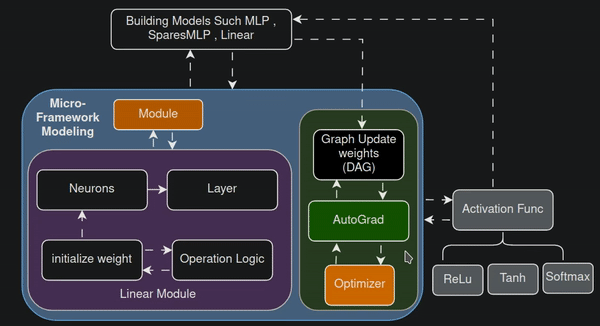Nano-AutoGrad Micro-Framework
a micro-framework that allows you to build and train neural networks from scratch based on automatic differentiation and computational graphs
Nano-AutoGrad
This project provides a lightweight Python micro-framework for building and training neural networks from scratch based on automatic differentiation and computational graph engine.

Installation
</div>
Introduction
Nano-AutoGrad is a micro-framework that allows you to build and train neural networks from scratch based on automatic differentiation and computational graphs.

Installation
You can install Nano-AutoGrad using pip:
pip install nano-autograds
Features
-
Nano-AutoGrad offers the following features:
- Automatic Differentiation: Nano-AutoGrad automatically * computes gradients, making it easy to perform gradient-based optimization.
- Computational Graph Engine: It leverages a computational graph representation to efficiently compute gradients and perform backpropagation.
- Lightweight and Efficient: Nano-AutoGrad is designed to be lightweight and efficient, suitable for small to medium-sized neural networks.
- Easy-to-Use API: The framework provides a simple and intuitive API, allowing users to define and train neural networks with ease.
- Integration with NumPy: Nano-AutoGrad seamlessly integrates with NumPy, enabling efficient array operations and computations.
Usage
To get started with Nano-AutoGrad, refer to the documentation for detailed usage instructions, examples, and API reference. Here are some basic steps to build and train a neural network using Nano-AutoGrad:
-
examples 1 :
import numpy as np import autograd.core.nn as nn import autograd.torch.optim as nn class MyNeuralNetwork(na.Module): def __init__(self): self.linear = na.Linear(2, 1) def forward(self, x): return self.linear(x) network = MyNeuralNetwork() optimizer = na.SGD(network.parameters(), lr=0.1) -
Example 2 : building ‘Linear Model’ using torch autograd engine
import autograd.torch.nn as nn import autograd.torch.tensor as Tensor import autograd.torch.optim as SGD import autograd.functiona as F class Model(nn.Module): def __init__(self): super().__init__() self.l1 = nn.Linear(784, 1568, name='l1') self.l2 = nn.Linear(1568, 392, name='l2') self.l3 = nn.Linear(392, 10, name='l3') def forward(self, x): z = F.relu(self.l1(x)) z = F.relu(self.l2(z)) out = F.log_softmax(self.l3(z)) return out model = Model() optimizer = autograd.optim.SGD(model.parameters(), lr=5e-2, weight_decay=1e-4) scheduler = autograd.optim.lr_scheduler.LinearLR(optimizer, start_factor=1.0, end_factor=0.75, total_iters=num_epochs)Examples
The Nano-AutoGrad repository provides various examples demonstrating the usage of the framework for different tasks, such as linear regression, classification, and more. You can explore the examples directory in the repository to gain a better understanding of how to use Nano-AutoGrad in practice. Contributing please
Nano_AutoGrads_tutorial_Linear_model
Nano_AutoGrads_tutorial_Sparse_Networks
Using Nano-AutoGrads to classify MINIST handwritten digits
Contributions
Nano-AutoGrad are welcome! If you have any bug reports, feature requests, or want to contribute code, please open an issue or submit a pull request on the official GitHub repository. License
Nano-AutoGrad is released under the MIT License. Please see the LICENSE file in the repository for more details. Acknowledgements
We would like to thank the contributors and the open-source community for their valuable contributions to Nano-AutoGrad. Contact
For any inquiries or further information, you can reach out to the project maintainer, Youness El Brag, via email at youness.elbrag@example.com.
Please note that you may need to update the contact email address with the appropriate one.


